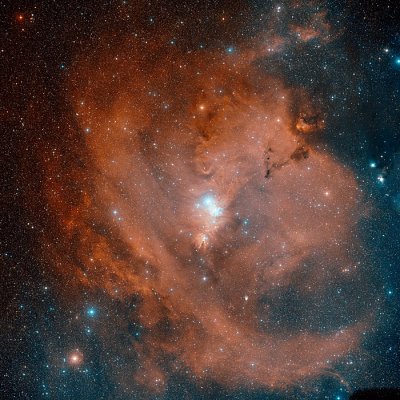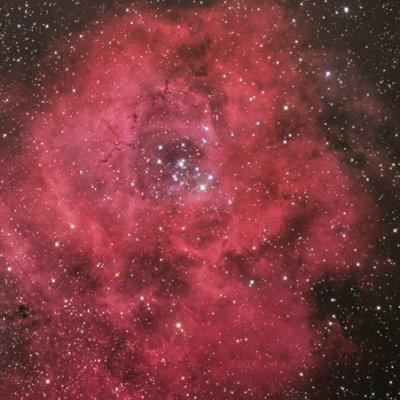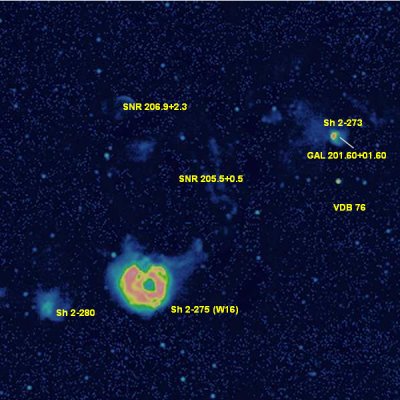
The Fox Fur nebula (Sh 2-273) is ionised primarily by the O7V binary star S Mon. The famous Cone nebula appears south of S Mon and its surrounding star cluster NGC 2264.
Source: Davide De Martin - http://www.skyfactory.org
This sector contains two major OB associations, each with its own complex of molecular clouds - Mon OB1 and Mon OB2, as well as Plaskett's star, one of the most massive binary star systems known in the Milky Way.
Mon OB1
The most detailed survey of the Mon OB1 molecular clouds was published by Oliver, Masheder and Thaddeus in 1996. They map the location of 34 molecular clouds in this direction, 20 of which appear to be at the distance of the Mon OB1 association. These 20 clouds contain about 135 thousand solar masses of gas and dust. [1]
Despite the huge 14° x 5 ° extent of Mon OB1 as defined by Ruprecht, Humphreys' 1978 paper lists only one ionising member - the O7V binary star S Mon (HD 47839). Her updated 1984 catalog adds the O9 class HD 45314 (discussed in the commentary on the Orion (200° - 190°) sector to the west) and 4 B-class stars (HD 47961, HD 48717, HD 44637 and HD 46883). [2]
A detailed study of S Mon, the binary central star of the star cluster NGC 2264, derived a spectral type of O9.5V for its secondary star [3], with an orbital period of 9247 ± 64 days (a bit over 25 years), 35 and 24 solar masses respectively for the primary and secondary star, and a distance of 950 pc. [4]
Both S Mon and HD 47961 are part of NGC 2264, according to Kharchenko, which is commonly described as the "Christmas tree cluster". She gives a distance of 660 pc and an age of 6.4 million years for the cluster. Besides S Mon, she lists DM +10 1202 = HD 260986 (B 2 IVN), HD 47887 (B2 III:), HD 262042 (B 2 V) and HD 47961 (B2V...) as ionising members. [5] SIMBAD also lists HD 46883 as a member of NGC 2264.
BFS give a distance estimate of 800 pc for Sh 2-273, the nebula ionised by NGC 2264. [6] Sh 2-273 is often called the Fox Fur nebula because of the mottled appearance of the nebula near the central cluster.
Sh 2-273 also contains the famous Cone nebula, a pillar of gas and dust containing the infrared source [MRC90] IRS E] embedded in a Bok globule at its tip. [7] The infrared source IRAS 06384+0932 (Allen's source, NGC 2264 IRS 1), which appears to be a hot B-class star about 3500 times more luminous than our Sun [8], is located just beyond the tip of the Cone nebula and may be creating a stellar wind that energises and shapes the nebula. [9]

This microwave image shows the main complexes of molecular clouds in the sector as well as the ionising stars, clusters and associations.
Source: Galactic Plane Explorer microwave image
There are three major complexes of molecular clouds in Mon OB1, denoted as [OMT96] 7, [OMT96] 11, and [OMT96] 16. The 52 thousand solar mass [OMT96] 16 surrounds both Sh 2-273 and NGC 2264. The 24 thousand solar mass [OMT96] 7 and the 21 thousand solar mass [OMT96] 11 form, respectively, the western and eastern ends of a region of clouds further south. [OMT96] 7 contains the Lynds dark nebulae LDN 1600, 1601 and 1604 as well as the bright nebulae LBN 887 and 889. [OMT96] 11 contains the association of reflection nebulae Mon R1 [10] (including the reflection nebulae NGC 2245 and 2247 and the O9Ve class young stellar object VY Mon), the Lynds dark nebula LDN 1605 and the Lynds bright nebulae LBN 901 and 904. [1] These three cloud complexes are clearly visible at microwave frequencies in the Galactic Plane Explorer. [OMT96] 11, in particular, contains 7 Avedisova star formation regions. [OMT96] 7 contains 1 ([Avedisova 1887]).
The brightest radio source in the direction of the Mon OB1 molecular clouds is the dusty, diffuse HII region [LPH96] 201.663+1.643 (GAL 201.60+01.60, DA 214, [GS55] 100) [11], [12], which is located southwest of the NGC 2264 star cluster, apparently within or behind the northern tip of the molecular cloud [OMT96] 11. Two little-studied O5 class stars may ionise this nebula: GSC 00737-01170 and GSC 00737-00898. [11] (Note, however, that SIMBAD says that GSC 00737-00898 is a B-class star.) GSC 00737-01170 appears to be the same as the star Tyc 0737-01170-1 and ASCC 932559 and the O5 spectral type comes from a measurement made by a prism attached to the 70cm Maksutov telescope at the Abastumani Observatory in Ukraine. [13] There is an obvious infrared shell visible at this location in the MSX A band image. Avedisova includes the star cluster NGC 2259, the young stellar object IRAS 06335+1057 (WB89 840) and the dark nebula LDN 1608 in the same star formation region as [LPH96] 201.663+1.643 [Avedisova 1892].
The reflection nebula NGC 2261, often called Hubble's Variable Nebula, is found at (203.751°, +1.277°), southeast of [LPH96] 201.663+1.643. The famous US astronomer Edwin Hubble reported that this nebula appeared to change its shape in a series of photographs taken over 8 years. [14]. It is now known that these changes are actually caused by variations in the variable star R Mon, which illuminates the nebula. R Mon is a very active class B0 Herbig star with a thick accretion disk, jet outflows and an orbiting companion star. It appears to be located at about the same distance as the Mon OB1 molecular clouds. [15]
In addition to NGC 2264, Kharchenko lists a second ionising cluster in the direction of Mon OB1. This star cluster appears to be located behind Mon OB1 at a distance, 1329 pc, that makes it closer to Mon OB2. It has an age of 269.1 million years and contains the ionising star DM +8 1399 (B2IV). [5]
HD 45166 is a peculiar Wolf-Rayet / B7 class binary, located towards the southern boundary of Mon OB1. It has an orbital period of 1.6 days and a distance of 1300 ± 200 pc. [16]
Supernova remnants
Two supernova remnants lie to the east of the Mon OB1 molecular clouds, SNR 205.5+0.5 (the Monoceros Loop) and SNR 206.9+2.3 (AJG 5). One set of distance estimates suggests that the Monoceros loop is located along with Mon OB2 on the near side of the Perseus arm at about 1600 pc, but AJG 5 is much further away, 6900 pc, a distance usually associated with the Outer arm. [17]
The Rosette molecular clouds

The Rosette nebula is ionised by the young massive star cluster NGC 2244.
Source: Dean Salman - http://www.sharplesscatalog.com
The only comprehesive study published to date on the Rosette molecular clouds surrounding the Mon OB2 association is a 1980 paper by Blitz and Thaddeus. They divide the clouds into 10 complexes with a total of about 130 thousand solar masses of molecular gas and estimate the distance to be 1600 pc. [18] A follow-up study published in 1998 by Schneider and colleagues presented more detailed observations of part of the Rosette molecular clouds and some embedded infrared sources. [19]
Humphreys lists 32 ionising stars in Mon OB2 (including 10 O-stars and 22 B-stars). [2] Many of these are concentrated in the massive young star cluster NGC 2244. Kharchenko gives an age of 5 million years and a distance of 1440 pc for NGC 2244. She lists 9 ionising stars, including the O-stars HD 46056 (O8 V e:), HD 46149 (O8.5V), HD 46223 (O4 V(f)), HD 46202 (O9 V), and the B-stars HD 259012 (B2V), HD 46106 (B1V), HD 259105 (B2V), HD 259135 (B1:V:N), and TYC 154-2444-1 (B2V). [5] A recent Chandra X-ray telescope survey of NGC 2244 also lists HD 46150 (O5f V), HD 46485 (O7 V), HD 258691 (O9f V), HD 259238 (B0 V), HD 46106 (B0.2 V), MJD 95 (B0.5V), IRAS 06309+0450 (B0.5V) and 19 B1 to B3 class stars, with about 30 ionising stars for NGC 2244 in total. The Chandra study cites a distance of 1400 pc and an age of 2 million years. It reports that most of the cluster is centred around the O5f V star HD 46150 with little clustering around the hotter O4 class HD 46223. [20]

The Rosette nebula (Sh 2-275, W16) is the most prominent object in this radio image.
Source: Galactic Plane Explorer radio image
NGC 2244 ionises the famous Rosette nebula (Sh 2-275, W16). This HII region is a blister at the northwest end of the Rosette molecular clouds and has largely destroyed the molecular gas surrounding it, with only a small clump ([BT80] H) remaining. [18]
An infrared study of the Rosette molecular clouds found 7 embedded star clusters other than NGC 2244. At least three of these clusters may have been triggered by the ionisation front associated with NGC 2244 and the Rosette nebula. [21]
Kharchenko lists 3 ionising clusters within the traditional boundary of Mon OB2 other than NGC 2244, all to the north of the Rosette molecular clouds. Collinder 106 has a distance of 1600 pc, an age of 5.4 million years, and contains 3 ionising stars: HD 46966 (O8.5 V), HD 47088 (B1 III), and HD 47107 (B1.5 Ia). [5] The incredible Plaskett's star (HD 47129), one of the most massive O-star binary systems known, also appears in the direction of Collinder 106. Plaskett's star contains a 42.5 solar mass O 7.5 I supergiant and a 51 solar mass O6 I supergiant orbiting each other with a period of 14.4 days. [22] It is named after the Canadian astronomer J.S. Plaskett, who investigated the properties of the system in 1921-22. [23]
Collinder 107 has a distance of 1450 pc, an age of 10.7 million years and contains 3 B-class ionising stars. Collinder 97 is much closer and older with a distance of 500 pc and an age of 208.9 million years. It contains the ionising star HD 45910 (B2:IIIpshev). [5]
The HII region Sh 2-280 appears to be located near or at the edge of the Rosette molecular clouds. Avedisova gives a distance of 1500 ± 300 parsecs and suggests two possible ionising stars, the O7 HD 46573 and the B0 III giant HD 46847. [24] BFS give a slightly larger distance estimate of 1700 pc. [6]
Nearby objects
The northern part of the nearby ionising cluster Platais 6 appears at the bottom of this sector. According to Kharchenko, the 61.6 million year old cluster Platais 6 is located at a distance of 348 pc and contains the ionising B2/3 V class star HD 43286. [5] The Northern Filament of the Orion molecular clouds is visible in microwaves near Platais 6 and is located at a similar distance of 390 pc. [25]
Nebulae in this sector
Notes
1. ^ Oliver, R. J., Masheder, M. R. W., & Thaddeus, P. 1996, Astronomy and Astrophysics, A new CO survey of the Monoceros OB1 region.
2. ^ Humphreys, R. M. 1978, Astrophysical Journal Supplement Series, Studies of luminous stars in nearby galaxies. I. Supergiants and O stars in the Milky Way. and the unpublished catalogs available here.
3. ^ Gies, Douglas R., Mason, Brian D., Hartkopf, William I., McAlister, Harold A., Frazin, Richard A., Hahula, Michael E., Penny, Laura R., Thaller, Michelle L., Fullerton, Alexander W., & Shara, Michael M. 1993, Astronomical Journal, Binary star orbits from speckle interferometry. 5: A combined speckle/spectroscopic study of the O star binary 15 Monocerotis
4. ^ Gies, Douglas R., Mason, Brian D., Bagnuolo, William G., Jr., Hahula, Michael E., Hartkopf, William I., McAlister, Harold A., Thaller, Michelle L., McKibben, William P., & Penny, Laura R. 1997, Astrophysical Journal, The O-type Binary 15 Monocerotis Nears Periastron
5. ^ Kharchenko, N. V., Piskunov, A. E., Röser, S., Schilbach, E., & Scholz, R.-D. 2005, Astronomy and Astrophysics, Astrophysical parameters of Galactic open clusters
6. ^ Blitz, L., Fich, M., & Stark, A. A. 1982, Astrophysical Journal Supplement Series, Catalog of CO radial velocities toward galactic H II regions
7. ^ Mendoza, E. E., Rodriguez, L. F., Chavarria-K., C., & Neri, L. 1990, Monthly Notices of the Royal Astronomical Society, Compact Radio and Infrared Sources Near the Centre of the Bipolar Outflow NGC2264D
8. ^ Schreyer, K., Stecklum, B., Linz, H., & Henning, Th. 2003, Astrophysical Journal, NGC 2264 IRS 1: The Central Engine and Its Cavity
9. ^ Scarrott, S. M. & Warren-Smith, R. F. 1989, Monthly Notices of the Royal Astronomical Society, The nature of the optical nebulosity near GL 989
10. ^ Racine, R. 1968, Astronomical Journal, Stars in reflection nebulae
11. ^ McCullough, P. R. & Chen, R. R. 2002, Astrophysical Journal, An Alternative to Spinning Dust for the Microwave Emission of LPH 201.663+1.643: An Ultracompact H II Region
12. ^ Caswell, J. L. 1968, Astronomical Journal, Radio Observations of Two H II Regions
13. ^ Voroshilov, V. I., Guseva, N. G., Kalandadze, N. B., Kolesnik, L. N., & Kuznetsov, V. I. 1985, Kiev, Izdatel'stvo Naukova Dumka, 1985, 140 p. In Russian., Catalog of BV magnitudes and spectral classes of 6000 stars
14. ^ Hubble, E. P. 1916, Astrophysical Journal, The variable nebula NGC 2261.
15. ^ Close, L. M., Roddier, F., Hora, J. L., Graves, J. E., Northcott, M., Roddier, C., Hoffmann, W. F., Dayal, A., Fazio, G. G., & Deutsch, L. K. 1997, Astrophysical Journal, Adaptive Optics Infrared Imaging Polarimetry and Optical HST Imaging of Hubble's Variable Nebula (R Monocerotis/NGC 2261): A Close Look at a Very Young Active Herbig Ae/Be Star
16. ^ Steiner, J. E. & Oliveira, A. S. 2005, Astronomy and Astrophysics, The qWR star <ASTROBJ>HD 45166</ASTROBJ> . I. Observations and system parameters
17. ^ Case, Gary L. & Bhattacharya, Dipen 1998, Astrophysical Journal, A New Sigma -D Relation and Its Application to the Galactic Supernova Remnant Distribution
18. ^ Blitz, L. & Thaddeus, P. 1980, Astrophysical Journal, Giant molecular complexes and OB associations. I - The Rosette molecular complex
19. ^ Schneider, N., Stutzki, J., Winnewisser, G., & Block, D. 1998, Astronomy and Astrophysics, The Rosette Molecular Complex. I. CO observations
20. ^ Wang, Junfeng, Townsley, Leisa K., Feigelson, Eric D., Broos, Patrick S., Getman, Konstantin V., Román-Zúñiga, Carlos G., & Lada, Elizabeth 2008, Astrophysical Journal, A Chandra Study of the Rosette Star-forming Complex. I. The Stellar Population and Structure of the Young Open Cluster NGC 2244
21. ^ Phelps, Randy L. & Lada, Elizabeth A. 1997, Astrophysical Journal, Spatial Distribution of Embedded Clusters in the Rosette Molecular Cloud: Implications for Cluster Formation
22. ^ Bagnuolo, William G., Jr., Gies, Douglas R., & Wiggs, Michael S. 1992, Astrophysical Journal, Tomographic separation of composite spectra. I - The components of Plaskett's Star
23. ^ Struve, Otto 1948, Astrophysical Journal, J. S. Plaskett's Star of Large Mass, HD 47129.
24. ^ Avedisova, V. S. & Kondratenko, G. I. 1984, Nauchnye Informatsii, Exciting stars and the distances of the diffuse nebulae
25. ^ Wilson, B. A., Dame, T. M., Masheder, M. R. W., & Thaddeus, P. 2005, Astronomy and Astrophysics, A uniform CO survey of the molecular clouds in Orion and Monoceros



